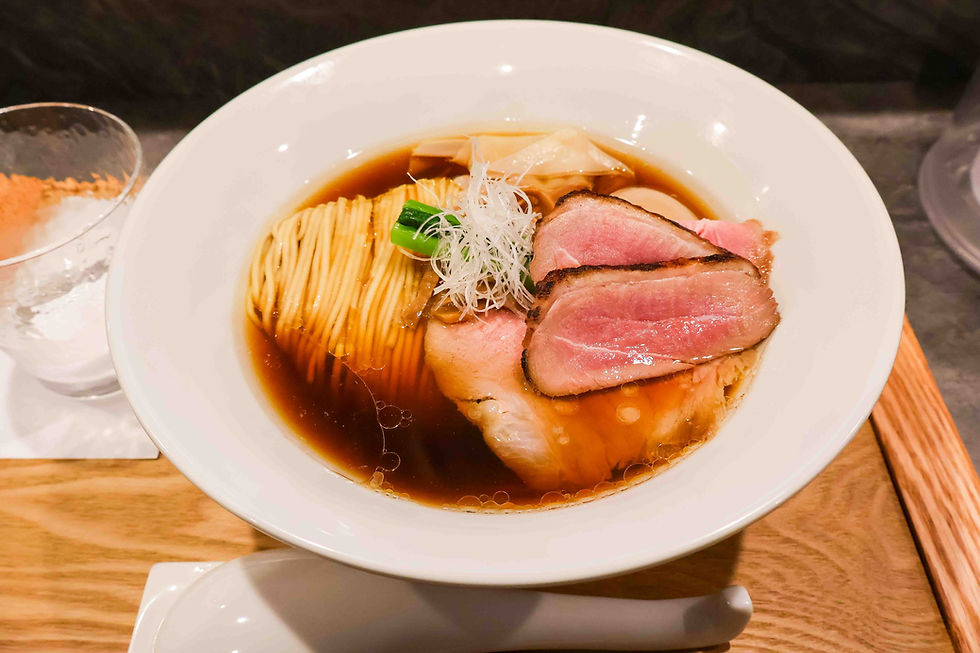Tsuta: Michelin Star Ramen – Worth the Hype?
- Frank
- Feb 24, 2020
- 3 min read
Updated: Nov 24
In 2015, Tsuta (蔦) shook the culinary world, being the first ever ramen restaurant to receive a Michelin star. But is their ramen worth the hype?
Famous before Michelin
Before its Michelin star status, Tsuta Japanese Soba Noodles was already well recognized in Japan. But this popularity reached new heights after the big star in 2015. Tsuta’s lines naturally got longer.

So this brings us back to the question – is it worth the hype? Is it worth waiting in line for? Let’s objectively have a look at Tsuta’s famous ramen.
Ramen at Tsuta – Is It Special?
While they serve various ramen, the bowl to order is with shoyu (soy sauce) seasoning. Owner Onishi-san has handpicked the finest shoyu from Wakayama prefecture.

This shoyu is barrel-aged for two whole years and is blended with other shoyu from Nagano and Hyogo prefectures. There are other elements in the seasoning too, like mussel extract and beef.

They use THREE soups: 1) chicken (including the prized Shamrock breed) and vegetables, 2) asari clam and kelp, and 3) niboshi and bonito fish flakes. Together, seasoning and soup form a gentle river of unbelievable umami.

It doesn’t stop there. Truffle oil is drizzled on top, but with restraint. The shoyu seasoning is still boss. Fig compote adds a sweet bounciness and porcini mushroom cream some extra savoriness. Furthermore, a dollop of balsamic vinegar adds a jolt of sourness.

The toppings are as magnificent as the soup, from the shabu shabu-like A5 Wagyu, to the Iberico pork, to the perfectly runny egg. All of this results in a carefully crafted, well-balanced ramen.

The thin noodles are a blend of 6 types of wheat flour, including from France and Hokkaido.
Read about Nakiryu, known for its Michelin star spicy ramen.
Shio Ramen Sidekick
As mentioned, they serve other ramen, including a shio (salt) ramen. A few things are different from the shoyu. First of all, they place red amaranth dramatically on top. They also replace the porcini mushroom cream with a lighter navy bean and bottarga (salted fish roe) sauce.

Lastly, there’s bacalhau (dried cod) and olive powder, and a tomato for acidity. Overall, the bowl carries a lighter, saltlier flavor but the soup is definitely more oily. It’s a great bowl. But I believe the shoyu is still the star of the show.
Any Drawbacks?
From the language used, you can probably guess I’m a fan of Tsuta. But if there are any drawbacks, perhaps these stand out.
Firstly, expect to wait 45 minutes to even 2 hours. Tsuta used to have a system where you’d arrive early in the morning and be asked to come back at an assigned time.
They’ve done away with this at their new Yoyogi-Uehara location.
While they might reintroduce this system in the future…for now, you just wait in line. If you don’t like waiting, this could be a turn off.

Another thing to mention is that Tsuta has set up shops in Singapore, the Philippines, Taiwan, and the US. Some may argue this takes away from the Japan location. But you can’t blame them for wanting to capitalize on their success.
Despite this, the most important thing to remember is that their ramen is incredible. In this sense, it could be very well worth the wait and commitment.
Final Thoughts and What to Order
The luxurious black truffle sheet ramen (¥3,550) is currently not available, as there’s likely less demand from locals (this article was updated in 2020). The standard shoyu ramen (#2 below) starts a reasonable ¥1,200. It’s all you need – it includes all the wonderful elements described above.

To each their own though. If you’re waiting a long time and don’t come to Japan that often, it might be fun to splurge (adding more toppings on the menu’s right side).
On a separate note, if you’ve only enjoyed heavy ramen up to now, it might be harder to appreciate Tsuta. If you’re craving milky tonkotsu (pork bone) ramen or hearty miso ramen, Tsuta might not do it for you.
But do bear in mind that Tsuta is refined, delicate ramen at its best. In short, Tsuta is the real deal and worth waiting in line for.
Here’s your complete guide to all three of Tokyo’s Michelin star ramen shops. Or get info about all three in the video below!









